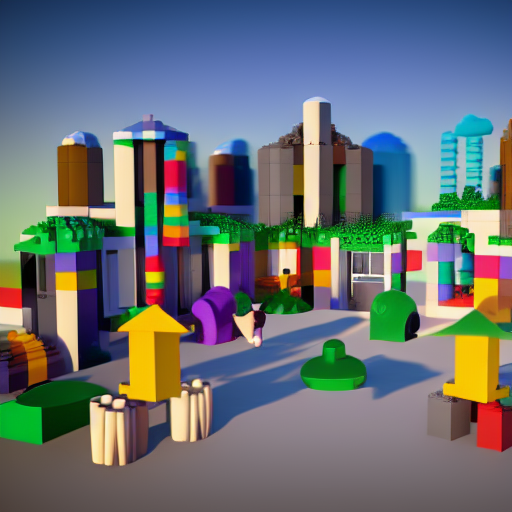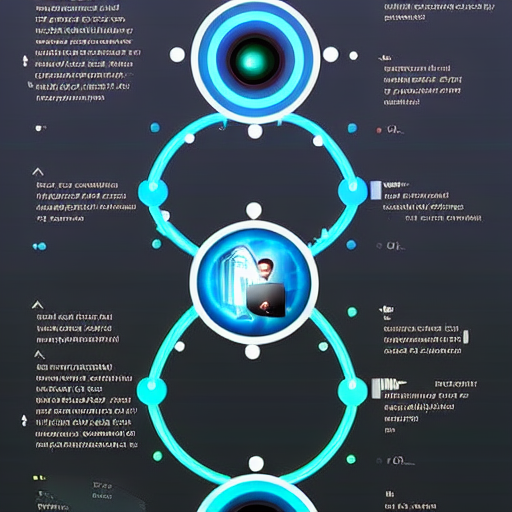Unlock the Building Blocks of the Metaverse – Metaverse Tech 101
Introduction
The Building Blocks of the Metaverse are essential to understanding this exciting new virtual world that has been generating a lot of buzz lately. The Metaverse is a collective virtual shared space where people can interact with each other and digital objects in a seemingly real environment. But how does it all work? In this blog, we will explore the foundational elements that make up the Metaverse, from virtual reality to blockchain, decentralized systems, and more. By taking a deep dive into the technology behind the Metaverse, we’ll discover its potential impact on society and the immersive and transformative experiences it can create. So, let’s dive in and explore the Building Blocks of the Metaverse!
List of Technologies Used In Metaverse
Virtual Reality (VR) – The #1 Building Blocks of the Metaverse
Virtual reality (VR) is one of the essential Building Blocks of the Metaverse, providing users with a truly immersive experience. It is an immersive technology that provides users with a sense of presence and allows them to engage with digital objects in a way that is not possible with traditional screens or interfaces. In the Metaverse, VR can transport users to a virtual world, where they can explore, socialize, and participate in various activities.

The potential applications of VR in the Metaverse are vast, from virtual events and conferences to gaming, education, and even therapy. As technology continues to advance, so does the potential for VR to create new and innovative experiences. With the ability to simulate real-world scenarios and environments, VR technology can revolutionize various industries, creating new possibilities for immersive learning, training, and entertainment.
Virtual Reality (VR) is a computer-generated simulation of a three-dimensional environment that can be interacted with using specialized equipment, such as a VR headset. VR allows users to feel as though they are physically present in the digital world. It’s one of the key technologies behind the Metaverse, as it enables users to experience a sense of presence, immersion, and interactivity that is not possible with traditional 2D screens.
Augmented Reality (AR) – The #2 Building Blocks of the Metaverse
Augmented reality (AR) is another crucial Building Block of the Metaverse, which enables users to experience digital objects overlaid onto the real world. It uses a combination of sensors, cameras, and computer vision to create an interactive and immersive experience. AR technology has already made its way into our daily lives, with popular apps like Snapchat and Instagram filters, but its potential in the Metaverse is enormous.
In the Metaverse, AR can enhance the real world, creating an even more immersive experience. For instance, users could overlay digital information on the physical environment, creating a more interactive and informative experience. AR could also enable users to socialize and interact with digital objects and avatars in a more seamless way, as if they were a part of the real world.
The potential for AR in the Metaverse is vast, with applications in gaming, education, tourism, and beyond. With AR, users can explore a virtual world that blends seamlessly with the real world, creating new opportunities for entertainment and learning. As technology continues to advance, so does the potential for AR to create even more immersive and interactive experiences.
Augmented Reality (AR) is a technology that overlays digital information onto the user’s view of the real world. Unlike VR, which creates a completely artificial environment, AR enhances the user’s perception of the world around them. This technology can be used to display information, such as product details or navigation instructions, directly in the user’s field of view.
Web3 Technologies – The #3 Building Blocks of the Metaverse
Web3 is a key Building Block of the Metaverse, which refers to the next generation of the internet that is built on decentralized technologies. It is a vision of the internet that is open, transparent, and democratic, with no central authority controlling it. Web3 enables a trustless system, where transactions and data are verified and validated by the network itself, rather than a central entity.
In the Metaverse, Web3 can enable a decentralized economy, where users can own and control their digital assets, participate in governance and decision-making, and transact with each other without intermediaries. This can enable a new era of digital ownership and value creation, where users can monetize their creativity and participate in a fair and transparent economy.

Web3 technologies like blockchain and smart contracts can also enable new forms of social interaction and organization in the Metaverse. Decentralized autonomous organizations (DAOs) can enable collective decision-making and governance, while decentralized social networks can create more open and transparent communication channels.
The potential for Web3 in the Metaverse is enormous, with applications in gaming, social media, finance, and more. As the internet continues to evolve, Web3 can enable a more inclusive, democratic, and fair digital economy, where users are in control of their own data and assets.
Web3 technologies, also known as decentralized technologies, are a set of protocols and technologies that allow for the creation of decentralized applications (dApps) on the Internet. These technologies, such as blockchain and peer-to-peer networking, enable users to interact with digital assets and services in a decentralized manner, without the need for a central authority. This is crucial for the Metaverse, as it allows for the creation of virtual worlds that are owned and controlled by their users.
Cloud Computing – The #4 Building Blocks of the Metaverse
Cloud technology is an essential Building Block of the Metaverse, enabling the storage and delivery of vast amounts of data and content to users across the world. It is a technology that allows users to access and share data, applications, and services over the internet, without the need for local hardware or infrastructure.
In the Metaverse, cloud technology can enable a seamless and immersive experience, where users can access a vast array of content and applications from anywhere in the world. Cloud technology can facilitate real-time interaction, enabling users to engage with each other and digital objects in a way that feels natural and responsive.
The potential for cloud technology in the Metaverse is vast, from gaming and entertainment to education and healthcare. With cloud technology, users can access and share immersive content and experiences, enabling a new era of digital collaboration and creativity.
As the Metaverse grows and evolves, the role of cloud technology will become even more critical, as it enables the scale and distribution of content and applications to users across the world. It can enable a more inclusive and accessible Metaverse, where users from all backgrounds and locations can participate and contribute.
Cloud computing is the delivery of computing services, including servers, storage, databases, networking, software, analytics, and intelligence, over the Internet (“the cloud”) to offer faster innovation, flexible resources, and economies of scale. Cloud computing allows for the creation of virtual worlds that can scale to meet the needs of millions of users. Additionally, it allows for the seamless integration of various technologies, such as VR and AR, into the Metaverse.
5G – The #5 Building Blocks of the Metaverse
5G is the 5th generation of mobile networks, which offers faster speeds and lower latency than previous generations. 5G technology is a crucial Building Block of the Metaverse, enabling faster, more reliable, and more efficient connectivity across the world. It is the next generation of wireless technology, with faster speeds, lower latency, and greater capacity than previous generations.
In the Metaverse, 5G can enable a more immersive and responsive experience, with real-time interaction and low latency. It can facilitate the transmission of large amounts of data, enabling users to access and share high-quality content and experiences. 5G can also enable new forms of communication and collaboration, enabling users to engage with each other in a more natural and intuitive way.
The potential for 5G in the Metaverse is vast, with applications in gaming, entertainment, education, and more. With 5G, users can access and share immersive experiences and content, from anywhere in the world, enabling a new era of digital collaboration and creativity.
As the Metaverse continues to evolve, the role of 5G will become even more critical, as it enables faster and more efficient communication and data transmission. It can enable a more inclusive and accessible Metaverse, where users from all backgrounds and locations can participate and contribute.
Artificial Intelligence (AI) – The #6 Building Blocks of the Metaverse
Artificial Intelligence (AI) is a fundamental Building Block of the Metaverse, enabling the creation of intelligent and responsive digital environments that can adapt to users’ needs and preferences. AI is a technology that allows machines to learn from data, make predictions, and perform tasks that typically require human intelligence.
In the Metaverse, AI can enable a more personalized and immersive experience, with intelligent and responsive digital environments that can adapt to users’ needs and preferences. AI can enable the creation of intelligent virtual agents that can interact with users in a natural and intuitive way, enhancing the overall user experience.
The potential for AI in the Metaverse is vast, with applications in gaming, entertainment, education, and more. With AI, users can access intelligent and personalized experiences and content, from anywhere in the world, enabling a new era of digital collaboration and creativity.
As the Metaverse continues to evolve, the role of AI will become even more critical, as it enables the creation of intelligent and responsive digital environments that can adapt to users’ needs and preferences. It can enable a more inclusive and accessible Metaverse, where users from all backgrounds and locations can participate and contribute.
Artificial intelligence (AI) refers to the simulation of human intelligence in machines that are programmed to think and learn. AI can be used to create virtual characters that can interact with users in a realistic and natural way, as well as to improve the overall user experience in the Metaverse.
Conclusion
In conclusion, the Building Blocks of the Metaverse are essential components that enable the creation of immersive and interactive digital environments that are poised to revolutionize the way we live, work, and play. From Virtual and Augmented Reality to Cloud Technology, Web3, 5G, and Artificial Intelligence, each of these building blocks plays a critical role in shaping the future of the Metaverse.
As these technologies continue to advance, the potential for the Metaverse is limitless, offering new opportunities for digital collaboration, creativity, and innovation. The Metaverse has the potential to connect people from all over the world, transcending boundaries and unlocking new possibilities for human expression and interaction.
It is an exciting time to be a part of this technological revolution, and we can’t wait to see where the Building Blocks of the Metaverse will take us next. As we look to the future, it is clear that the Metaverse will continue to evolve and expand, offering new opportunities and possibilities for generations to come.

